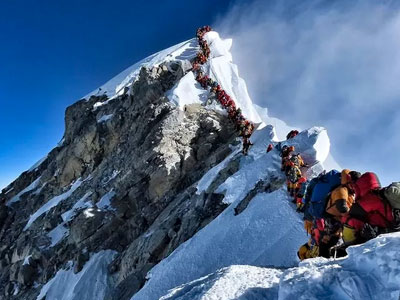- info@shikharadventure.com Get Travel Expert Advise
- +977 9841869254 (Dambar) Viber & Whatsapp
International Mt. Everest Day | 70 years of Amazing Accomplishments
The date of May 29th, 1953, is engraved in mountaineering history as the day Sir Edmund Hillary and Tenzing Norgay made the first successful climb of Mount Everest. As we approach the 70th anniversary of this momentous event in 2023, it is appropriate to reflect on the extraordinary achievements that have occurred on May 29th over the years. This blog attempts to give a complete analysis of Everest's historic first ascent, Kami Rita Sherpa's incredible 27th ascent, Hari Budha Magar's inspirational trip, and the impact of the increasing number of Everest climbers.
The Conquest of Everest: May 29th, 1953
 Sir Edmund Hillary and Tenzing Norgay made history on May 29, 1953, when they reached the top of Mount Everest. This section will dig into the path that led to this historic feat. It will examine the early efforts to climb Everest, the difficulties encountered by Hillary and Norgay, and the techniques they used to overcome the terrible terrain and harsh weather conditions. The influence of their victory on the world of climbing and following expeditions will also be investigated.
Sir Edmund Hillary and Tenzing Norgay made history on May 29, 1953, when they reached the top of Mount Everest. This section will dig into the path that led to this historic feat. It will examine the early efforts to climb Everest, the difficulties encountered by Hillary and Norgay, and the techniques they used to overcome the terrible terrain and harsh weather conditions. The influence of their victory on the world of climbing and following expeditions will also be investigated.
Celebrating 70 Years: Kami Rita Sherpa's Extraordinary 27th Climb
.jpg) Kami Rita Sherpa, a highly skilled climber from the Everest area, has captivated the world's attention with his remarkable record of 27 successful Everest summit ascents. This part will go through Sherpa's history, his profound attachment to the mountain, and the obstacles he experiences on each ascent. It will look at the physical and mental preparation needed, the role of Sherpas in assisting climbers, and the influence of Sherpa culture on Everest trips. Furthermore, the significance of Sherpa's accomplishment in the context of climbing history, as well as the motivation it gives to future climbers, will be emphasized.
Kami Rita Sherpa, a highly skilled climber from the Everest area, has captivated the world's attention with his remarkable record of 27 successful Everest summit ascents. This part will go through Sherpa's history, his profound attachment to the mountain, and the obstacles he experiences on each ascent. It will look at the physical and mental preparation needed, the role of Sherpas in assisting climbers, and the influence of Sherpa culture on Everest trips. Furthermore, the significance of Sherpa's accomplishment in the context of climbing history, as well as the motivation it gives to future climbers, will be emphasized.
Hari Budha Magar: Overcoming Adversity to Pursue the Everest Dream
.jpg) The narrative of Hari Budha Magar demonstrates the victory of the human spirit over hardship. Magar encountered unprecedented hurdles in his quest to ascend Everest as a bilateral above-the-knee amputee. This part will go into Magar's personal experience, including his military service, the life-altering incident that resulted in his legs being amputated, and his unshakable drive to redefine what is possible. It will look at Magar's physical and mental preparations, the prosthetic limbs and adaptation techniques he used, and the support system he relied on. The segment will also underscore Magar's achievement's greater relevance in defying social assumptions and motivating those confronting their own hardships.
The narrative of Hari Budha Magar demonstrates the victory of the human spirit over hardship. Magar encountered unprecedented hurdles in his quest to ascend Everest as a bilateral above-the-knee amputee. This part will go into Magar's personal experience, including his military service, the life-altering incident that resulted in his legs being amputated, and his unshakable drive to redefine what is possible. It will look at Magar's physical and mental preparations, the prosthetic limbs and adaptation techniques he used, and the support system he relied on. The segment will also underscore Magar's achievement's greater relevance in defying social assumptions and motivating those confronting their own hardships.
The Rising Numbers: Everest's Growing Popularity
 Mount Everest, the beautiful mountain rising 8,848 meters (29,029 feet) above sea level, has long been associated with human perseverance and the quest of adventure. Every year, seasoned mountaineers from all over the world travel to the Himalayas in the hopes of conquering this challenging peak. Mount Everest experienced an astounding accomplishment in 2023, with the greatest number of climbers ever reaching the summit. Let us look into this incredible achievement and investigate the variables that contributed to such a historic occurrence.
Mount Everest, the beautiful mountain rising 8,848 meters (29,029 feet) above sea level, has long been associated with human perseverance and the quest of adventure. Every year, seasoned mountaineers from all over the world travel to the Himalayas in the hopes of conquering this challenging peak. Mount Everest experienced an astounding accomplishment in 2023, with the greatest number of climbers ever reaching the summit. Let us look into this incredible achievement and investigate the variables that contributed to such a historic occurrence.
Record-Breaking Statistics:
Mount Everest had an extraordinary rush of climbers in 2023, resulting in a record-breaking number of successful climbs. An astonishing amount of approx. 454 people stood atop the mountain this year breaking all prior records. This extraordinary feat not only demonstrates the ongoing fascination of the world's highest mountain, but it also demonstrates climbers' growing ability and the increased safety procedures in place.
Factors Contributing to the Surge:
Mountaineering technological developments have made climbing Mount Everest more accessible to a larger group of enthusiasts with each passing year. Climbers now have a major edge because to advancements in equipment such as lightweight and durable gear, breathable textiles, and increased safety gadgets.
Improved Training and Education: Mountaineering institutions and training centers across the world have focused on delivering complete training programs to prospective climbers. Climbers can better prepare for the challenges of Everest thanks to the availability of professional courses addressing technical skills, altitude acclimation, and risk management.
Enhanced Safety Measures: Mountaineering authorities and organizations have placed a greater focus on safety during Everest trips in recent years. Stricter restrictions, rigorous health exams, and the presence of experienced Sherpas have all contributed to reduce dangers and improve climber safety.
Mountaineering has grown in popularity as an adventure sport, drawing people from all walks of life who want to test their physical and mental boundaries. The ambition for personal accomplishment, along with the fascination of climbing the world's highest mountain, has fueled the boom of Everest climbers.
Impact on the Socioeconomic System:
The increasing number of climbers on Mount Everest in 2023 has a variety of social consequences. The increase in climbing activities has boosted local economies, notably in Nepal, where climbers demand services ranging from lodging and transportation to equipment rental and local guides. Local communities have also seen an increase in tourism-related enterprises and expanded job prospects.
Concerns about the environment:
The increased number of climbers has sparked worries about Mount Everest's environmental effect. While climbing officials have introduced stronger waste management measures, including as enforced garbage disposal by climbers, the increasing number of expeditions poses a risk to the region's delicate ecological balance. To reduce the ecological effect of growing footfall on Everest, sustainability programs and appropriate climbing methods must be promoted.
The year 2023 was a watershed moment in Mount Everest history, as it saw the largest number of successful climbers ever recorded. This astounding feat has been made possible by factors such as technical breakthroughs, greater training, enhanced safety precautions, and increased adventurism. However, striking a balance between adventure and sustainability is critical in order to maintain Mount Everest's natural beauty and biological integrity for future generations. As we commemorate this remarkable achievement, let us also consider the significance of responsible climbing and the need to maintain our planet's most breathtaking natural marvels.
As the 70th anniversary of the first climb of Mount Everest approaches, it is a moment for both celebration and contemplation. Hillary and Norgay's achievements, as well as those of Kami Rita Sherpa and Hari Budha Magar, are testaments to the tenacious spirit of human exploration and the quest of perfection. However, among the festivities, it is critical to address the issues brought by the growing number of climbers and to prioritize the preservation of Everest's natural beauty and ecological balance. We can guarantee that future generations have the chance to enjoy the beauty of Mount Everest while protecting its pristine environment by commemorating the legacy of these outstanding climbers and developing ethical climbing techniques.
May 29th serves as a reminder of the resilience of the human spirit and the remarkable achievements that can be attained when we dare to push the boundaries of what is possible.
Recent Post

Dashain Festival - The Most Celebrated Nepalese Holiday
Others
Exploring the Enchanting Mustang Valley: A Must-Visit Destination in 2023
Trekking
Nepal: A Melting Pot of Culture, Tradition, and Hospitality
Others
Annapurna Trek Guide: A Majestic Himalayan Adventure to Remember
Trekking
Ghandruk - A Cultural and Natural Heaven in the Annapurna Range
Trekking
Surviving the Everest Base Camp Trek: Overcoming the Challenges of Altitude and Weather
Trekking


